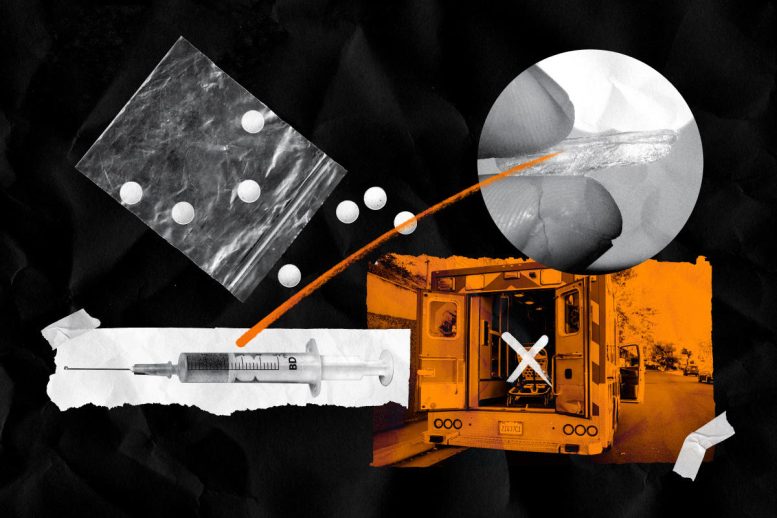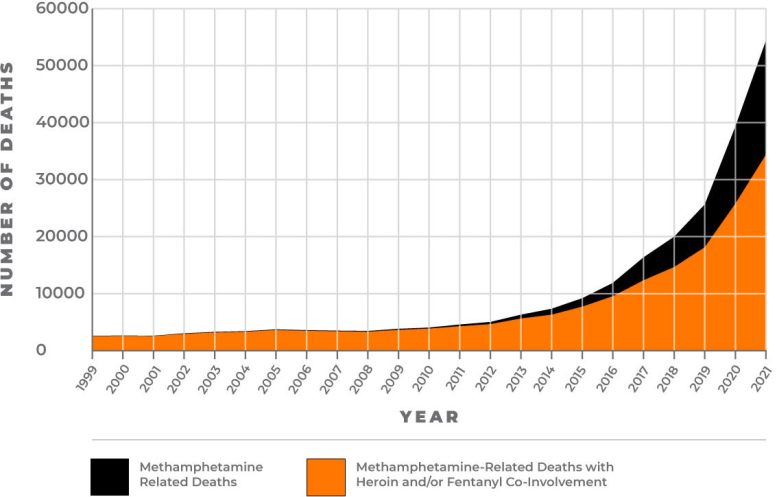
Many meth-related deaths are also tied to heroin and/or fentanyl, a new study finds. Credit: Michael B. Vincent
A staggering 50-fold increase in deaths related to methamphetamine has been recorded since 1999.
The mortality rate due to methamphetamine use in the United States has seen a fiftyfold surge between 1999 and 2021, according to a report published in the American Journal of Public Health. The study also highlights that a majority of these deaths also involved heroin or fentanyl.
“We looked at trends from 1999 to 2021 and we saw this staggering increase in methamphetamine mortality accompanied by a proportional increase in those deaths that also involved heroin or fentanyl,” said Rachel Hoopsick, a University of Illinois Urbana-Champaign professor of kinesiology and community health who led the research.

According to a new study led by U. of I. kinesiology and community health professor Rachel Hoopsick, a fiftyfold increase in methamphetamine deaths since 1999 may be the deadly result of the contamination or co-use of meth with opioids like heroin and fentanyl. Credit: Fred Zwicky
The U.S. Centers for Disease Control and Prevention (CDC) recorded 608 deaths due to methamphetamine use in 1999, however, that number skyrocketed to 52,397 in 2021. Researchers Hoopsick and R. Andrew Yockey from the University of Texas, Fort Worth, discovered that a significant portion of these deaths, 61.2%, also involved heroin or fentanyl. The alarming rise in methamphetamine-related fatalities, mainly between 2010 and 2021, shows no signs of slowing down, according to Hoopsick.
“We knew from behavioral studies that the use of stimulants, in general, as well as the use of stimulants with opioids, has been increasing over the past decade or two,” Hoopsick said. “But we didn’t know how deadly it was becoming. I think what is different now versus 10 years ago is we have a much more toxic unregulated drug supply here in the U.S.”
Methamphetamine by itself can be deadly, but its toxicity does not appear to have increased in recent years, Hoopsick said. The potency of illicitly manufactured fentanyl, however, has skyrocketed.

Meth-related deaths have reached historic levels, with deaths that co-involve heroin or fentanyl (orange) rising at a much higher rate than those attributable to meth alone (black), new research reveals. Credit: Michael B. Vincent
“Some of the newer methamphetamine deaths may have involved the unintentional co-use of fentanyl,” she said. “It’s possible that the supply of methamphetamine was adulterated with fentanyl or contaminated by fentanyl at some point in the drug-manufacturing process.”
Some methamphetamine users also choose to add an opioid to the mix to counter some of the stimulant effects of the meth, she said.
“There are some myths within the drug-using community that opioids can be used to prevent or reverse an overdose with stimulants,” Hoopsick said. “But it does not work. They may be making it more toxic, not less.”
The impetus for the study came from Hoopsick’s observations during a community-based research project at the Champaign-Urbana Public Health District. The goal was to better understand the experiences, needs, and preferences of people in the Champaign-Urbana community who inject drugs.
“I was really surprised to hear from the folks at the syringe service program that just as many of them were injecting methamphetamine as they were opioids, and many of them were co-using both types of substances,” Hoopsick said. “That got me thinking that the increase in methamphetamine mortality might be driven by the co-use of meth with illicitly manufactured fentanyl, in particular, which we’ve seen in the opioid overdose crisis is driving a lot of the deaths in the United States.”
The national data seems to support that hypothesis, she said.
Harm reduction is one of the only effective approaches for reducing drug-related deaths, Hoopsick said. Syringe exchange is one approach known to reduce the transmission of HIV or other infectious diseases.
Another avenue would be to help people test their drugs for the presence of substances like fentanyl. For example, people who inject drugs and participate in the syringe service program at the local health district asked for and received fentanyl-testing strips to help them determine whether their drugs also contain fentanyl.
Even better would be a service that tests the drugs to determine their composition and potency, Hoopsick said. Some communities also offer safe injection sites, ensuring that users are not alone and lessening the potential for overdose.
“A lot of our harm reduction efforts are geared predominantly toward people who are using opioids, but we need to think about how we can also reach those who are using stimulants or who may be co-using opioids and stimulants,” she said.
Reference: “Methamphetamine-Related Mortality in the United States: Co-Involvement of Heroin and Fentanyl, 1999–2021” by Rachel A. Hoopsick, Ph.D., MS, MPH, MCHES and R. Andrew Yockey, Ph.D., 2 February 2023, American Journal of Public Health.
DOI: 10.2105/AJPH.2022.307212








Be the first to comment on "Study Finds “Staggering Increase” in Methamphetamine Deaths – And It Has No Signs of Slowing Down"